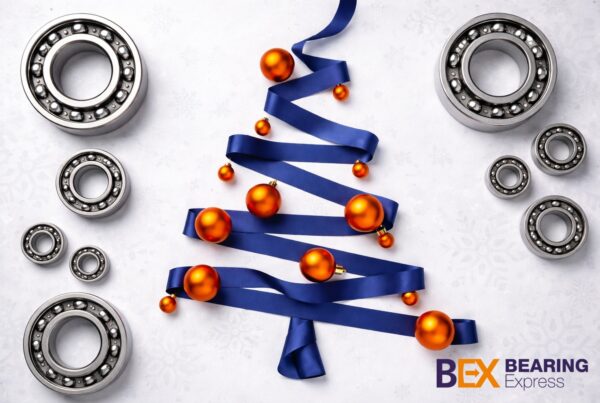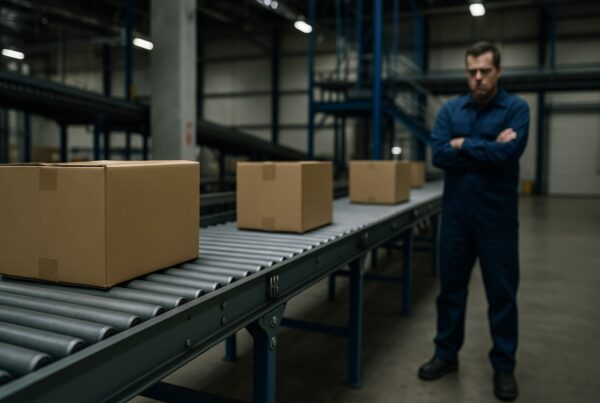Why use modern bearings in old equipment?
- The machine no longer runs in optimal condition (worn housing, worn fit, shaft misalignment).
- Operating conditions have changed compared to the original design (VFD drives, higher loads, dirtier environment).
- You want to extend maintenance intervals and reduce unplanned stops.
- The application includes electrical drive, vibration or a corrosive environment where standard steel bearings fail faster.
What is a hybrid bearing?
A hybrid bearing has steel rings but ceramic rolling elements (balls or rollers), usually silicon nitride (Si₃N₄). It’s a good “in-between” solution for old machines that now run under tougher conditions.
Documented advantages
- SKF: hybrid bearings are less prone to surface distress than steel–steel bearings, especially under poor lubrication.
- STLE: lower friction, less heat build-up, longer service life.
- ResearchGate publications: better fatigue resistance even under marginal lubrication.
Limitations
- More rigid – less tolerant of housing/shaft errors.
- Higher price – typically 2–4× a standard steel bearing.
- Best results only with the correct fit and correct grease.
What about full ceramic bearings?
With a full ceramic bearing not only the rolling elements, but the rings are ceramic too. These are mainly for high-speed, precision or highly corrosive applications (spindle motors, chemical pumps, centrifuges).
Advantages
- Excellent heat and corrosion resistance, longer fatigue life.
- Electrical insulation – helps prevent bearing current damage in VFD motors.
Limitations
- Lower thermal expansion – can tighten up when the housing gets hot.
- Does not like shock and vibration – use only with good alignment.
- Higher cost and more sensitive installation.
A modern bearing is only as good as its environment
On older machines, early failures often come from seals, grease points or worn housings – not from the bearing itself. A precision bearing will still fail quickly if a cracked seal lets dirt in, or if the grease nipple is blocked and the new bearing never gets fresh grease.
Lubrication – the “invisible upgrade”
If you upgrade to a modern bearing, upgrade the grease too. Synthetic, lithium-complex or polyurea greases can increase bearing life by 20–40%. For ceramic or hybrid bearings, a low-viscosity, silicone-free synthetic grease is recommended. Always clean the lubing system before filling – do not mix old mineral grease with the new one.
Vibration and balancing
Modern bearings – especially ceramic types – do not like vibration. Micro-impacts break the lubricant film and cause accelerated fatigue. On older machines it’s a good idea to measure base vibration first; above 3–5 mm/s RMS a ceramic bearing is usually not recommended.
Hybrid, ceramic or coated bearings are not “fancy extras” – they are problem solvers for electrical erosion, overheating, lubrication issues or corrosion. If you understand the problem and prepare the machine properly, a modern bearing can make an old machine run like new. But if you install it “just to try it,” you may be disappointed. No bearing – however modern – will fix bad fits or poor maintenance. Technology helps, experience makes it work.
If you have questions, contact us – or check the maintenance FAQ below.
Maintenance FAQ – Modern Bearings in Old Machines
Click on a question to open the answer.
1. If the bearing housing or shaft is already worn, should I install a modern bearing?
Not immediately. Hybrid and ceramic bearings are stiffer and less forgiving. If the housing is oval or the shaft is tapered/worn, the bearing will run under stress and will fail early. First restore the seat (sleeve, repair compound, re-machining), then install the modern bearing.
2. What fit tolerances should I use for a modern bearing?
A good starting point: shaft g6–f6, housing H7. But always check the manufacturer’s tables (SKF, NTN, SNR). Modern bearings do not like too-tight fits or thermal squeeze. A slightly looser fit is safer than an overheated, clamped bearing.
3. Can I hammer in a hybrid bearing or should I only heat it?
Do not hammer it in. Ceramic balls are brittle – shocks can cause microcracks that you won’t see, but the bearing will fail sooner. The safe way is to heat the inner ring to 60–90 °C with an induction heater, or use a proper installation tool that presses on the correct ring.
4. How do I know if there is bearing current in the machine?
Typical signs: small craters or fluting marks on the raceway or rolling elements of the removed bearing. This is common in VFD-driven motors. In this case, use a hybrid or electrically insulated bearing and check grounding/shaft bonding as well.
5. What grease should I use with ceramic or hybrid bearings?
Use a synthetic, high-temperature, low-viscosity grease – usually polyurea or lithium-complex. These do not leave deposits on the ceramic rolling elements and work well at higher speeds. Do not mix with old mineral greases – clean the lube lines first.
6. How much vibration can a modern hybrid bearing tolerate?
Up to about 3 mm/s RMS is generally safe. Between 4–6 mm/s is borderline. Above 6 mm/s you should expect faster fatigue because of the stiffer rolling elements. If the machine vibrates a lot (old fan, conveyor, unbalanced rotor), reduce vibration first or use a high-quality steel bearing instead.
7. Modern bearings are more expensive – do they really last longer?
In good conditions, yes – 2–3× service life is realistic, especially if the original problem was electrical erosion or poor lubrication. But if the environment is bad (worn seat, dirty grease, misalignment), they can fail sooner than standard bearings. A modern bearing cannot replace good installation.
8. Can I mix a hybrid bearing on one side and a steel bearing on the other?
Yes, in some shaft layouts. For example, hybrid on the drive end and steel on the non-drive end. Just make sure axial play is correct, because the two sides may have different thermal expansion. For electrical problems, insulating one side is often enough.
9. Is it worth using a modern bearing if the machine only runs occasionally?
Not always. If the load is low and runtime is short, a good steel bearing with modern grease is more economical. A modern bearing pays off when you are solving a real problem (bearing current, overheating, lubrication instability) or when downtime is very expensive.



